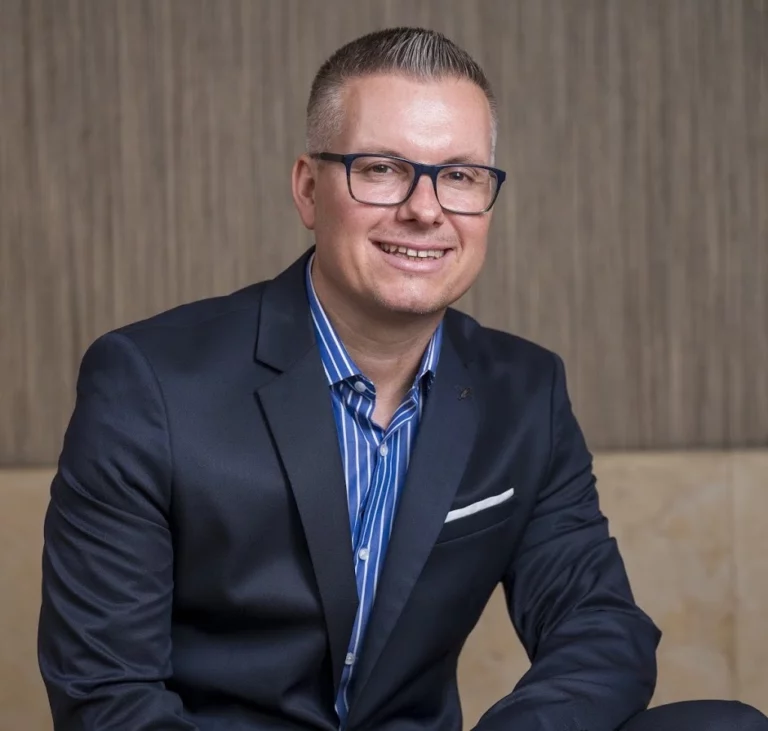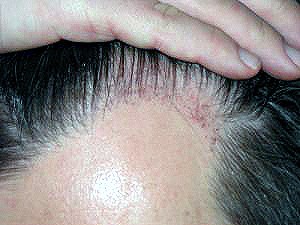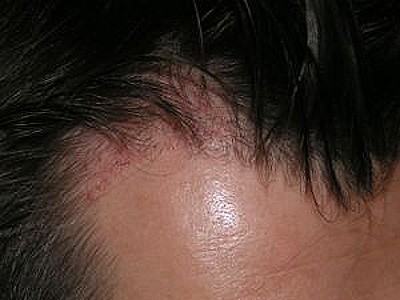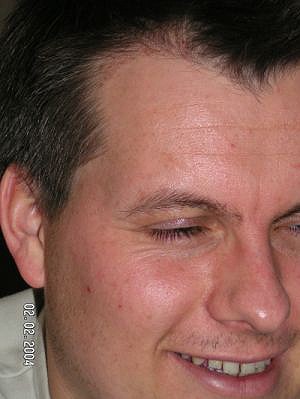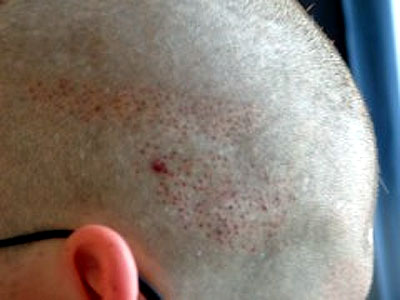
DHI hair transplantATION method (Choi Implanter) with a waiver of a shave, OFten offered in Turkey or Elsewhere: negative experience and necessary correction – repair
Since even nowadays the DHI method is still often mentioned as a “new method” on the internet, especially as an example in Turkey, the term DHI is very often used as a marketing tool, I would like to provide you with some information about DHI hair transplantation (mostly advertised on the internet as DHI technique without shaving ) and more detailed information about my own two underwent FUE procedures with the “DHI Technique” performed with DHI, once with the DHI technique/method and Choi Implanter and once classically with recipient sites creation by needles and insertion of the grafts by assistants.
My second Hair Transplant experience report and my FIRST Review from my FUE Surgery with Choi Implanter at DHI with negative experience, in November 2003
In November 2003, I underwent my second hair transplantation altogether, but this time my first surgery with the FUE DHI method, which was already highly praised on the Internet at that time.
Today, the DHI method is more frequently offered in a big way, especially in Turkey. Back in my time, it was more frequently offered in Greece (by DHI at various locations).
However if you research carefully, you will find that this method is nothing other than an FUE and differs only in the way the grafts are inserted and in the creating of the recipient sites. I was treated in their clinic in Greece, Athen, using the “DHI method” and Choi Implanter, with unfortunately negative experience as I was absolutely not satisfied with the result either and therefore had to gather further bad experiences.
Whether offered in Turkey or elsewhere: How does the DHI technique work?

The basis is the Choi Implanter, an auxiliary device/pin with which a recipient sites are created, but at the same time the graft is inserted. The implanter is first “loaded” and then, as a rule, the doctor uses the implanter to form the recipient sites and, at the push of a button, inserts the loaded graft into the recipient opening.
ATTENTION: IN TODAY´S TIMES THE DHI TECHNIQUE WITH IMPLANTER AND WITHOUT SHAVING IS JUST FREQUENTLY USED IN TURKEY AND IN ISTANBUL BY UNLICENSED AND INEXPERIENCES TECHNICIANS AND SO-CALLED BLACK MARKET MASS PROCESSING CLINICS

This is now the situation in many clinics in Turkey, with many surgeries being performed simultaneously in one room by unlicensed technicians. Especially the DHI technique with implanter and without shaving is often misused for marketing reasons in order to gain customers. Especially in Istanbul, Turkey, there are now some that advertise with these terms, but in which the entire surgery is often performed exclusively by inexperienced and unlicensed technicians and often there is not even a doctor present in the room. The risks of hair transplantation thus increase totally, which is why the ISHRS, the largest association of hair surgery, has also launched the campaign Fight the Fight2 against mass processing clinics.
“Many of the illegal clinics have fancy websites with references and testimonials that look very professional, especially in Turkey. However, the reality is that in the cheap assembly line clinics, the hair transplant may be performed by someone who has no experience regarding FUE surgeries and not even medical training.”
Jump to detailed information about the ISHRS.org “Fight The Fight” campaign
Why did I decide on DHI at that time? Arguments like: No or only little shaving/shaving, less redness, better hair growth direction and growth rate – also negative as well as positive reviews on the internet and forums were taken into account
The argumentation of the method today (how all the cheap clinics in Turkey argue), but also back in 2003! Only a few hair have to be shaved (in advertising, at least, the catchwords are usually DHI hair transplantation without shaving) and through the use of the Choi Implants, less redness is supposed to occur and the hair growth direction is supposed to be better controlled and the growth rate is supposed to be improved. This is at least the argumentation from a marketing point of view. In addition, even at that time there were critical and negative voices/evaluations about the DHI procedure, but also good evaluations/voices on the internet and in forums. Forums are certainly a good information medium, but there are also dangers lurking here, as things may be kept under wraps, or representatives/clinics may try to influence general opinion with hidden posts, see also the article Forums.
DHI experience report and disadvantages of a clinic group: FUE Choi Implanter Transplantation was performed by an inexperienced doctor
Unfortunately, however, an inexperienced doctor (after all, at least a doctor back then did the extraction of the grafts and formed the recipient openings with the implanter and inserted the grafts with the implanter, which were only “loaded” by the assistants only, compared to today in Turkey often everything is done completely only by assistants and often no doctor is present at all!) had operated on me at the time, which can certainly happen in clinic groups. Today’s providers of hair transplants on the internet are very often members of clinic groups, which may work with different doctors, so that the quality can vary and/or turn out differently depending on the surgeon and the level of staff.
However, clinic groups often like to “advertise” with results “in general”, but without explicitly assigning a result to a doctor. But when results are viewed, one would always have to ask which doctor exactly is responsible for this result, because otherwise the information content would be zero!
In any case:
When I arrived at DHI Medical in Athens, Greece, I first had the idea of having the old mini/micro grafts from my first hair transplant removed and replaced by follicular units, i.e. FUs. However, the doctor was of the opinion that it would be better to just “thicken” the hair, because then the old bad hair transplant would not be so visually noticeable.
In the end, I had just over 200 grafts transplanted. The implants were inserted with the implanter, which, however, left me with larger holes.
My negative experiences: Even months after the transplantation, redness and inflammation, as well as traces in the hairline after the FUE strip shave
The implanter had a size of approx. 1.0 – 1.2 mm in diameter. Even 3 – 4 months after the hair transplantation at DHI, there were still clear traces, sporadic red pustules, and inflammations, which I treated with antibiotic ointment. In addition, the hair direction was wrong and in the front row, instead of follicular units with 1 hair, too many follicular units with 3 or 4 hair were transplanted. As a result, there was a clear difference between the natural hair that was still present and those that were transplanted later.
The problem in the donor area/hair crown was that, in my opinion, too many hair were removed from too small an area. As a result, the traces of this removal can still be seen today, at least as soon as the hair is shaved.
By the way, this problem exists for all those who do not want to shave their hair completely. The main argument for an operation with strip shaving is that you do not need a complete shave for small FUE sessions/operations, which of course suits you as a patient because you usually do not like to shave yourself bald. It is argued that the longer hair cover the removal site, which is also completely correct.
The danger, however, is that too many follicular units are removed from a small area, which can be recognised later as stripes if the hair is cut very short…
Advice: Even if it is difficult. To be on the safe side, the hair in the crown should be shaved completely so that the doctor can remove it evenly over a larger area.
Before and after pictures of my second DHI-FUE without shaving (shaving) the reciepient area and with FUE strip shaving in the donor
Here is a picture of me in September-October 2003 before the treatment at DHI Medical in Athens
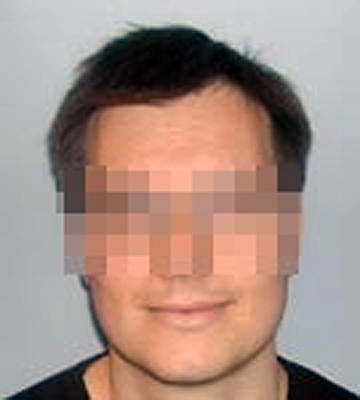
3. Hair surgery at DHI: Dr Bisanga’s evaluations and subsequent repair – corrective surgery with shaving baldness in June 2004
I had my third hair operation again at DHI Global in Athens, Greece.
Why a hair transplant at this clinic again?
I went there again because the clinic offered to repair the damage free of charge and I was also informed in advance that the repair/replacement surgery would be carried out by a more experienced doctor by then, Dr Bisanga.
I eagerly awaited the clinic’s and Dr. Bisanga’s evaluations, and upon arrival, he quickly told me that he did not like the result and that a correction was necessary. The direction of the hair was wrong and there were too many follicular units with 3-4 hair in the hairline. Most of these would have to be removed and the hairline completely redesigned with only single hair (follicular units with one hair) and in a natural shape. The management agreed with this assessment and gave their ok for a free correction.
We then also discussed together whether the traces that occurred during the insertion, as well as the healing problems, could possibly have been caused by incorrect use with the implanter. Apart from that, however, Dr. Zondos, for example, shows that very good results can be achieved with the Implanter if it is used correctly. It’s just sad that he didn’t operate on me at the time, which is why I would now like to urge everyone to find out exactly which doctor will operate on you and what know-how, experience and results this doctor can demonstrate before undergoing hair surgery!
The basic problem in my case was that the doctor of my first HT treatment had already placed implants in the wrong direction and the inexperienced doctor followed this wrong direction in the next transplantation.
This time with a shave and no use of the Choi Implanter, but rather the Creation of the recIpient Sites with needles and insertion of the grafts by assistants
In contrast to the first failed FUE operation at DHI, this time the head was completely shaved (Dr. Bisanga argued that this would enable him to work better) and Dr. Bisanga did not use an implanter! The recipient holes were made with classic needles and the grafts were inserted by experienced assistants. According to Dr. Bisanga, he has had good experience with this for years and has achieved many good results with exactly this procedure. Even though he does not work with the Choi Implanter himself, he was of the opinion that in my first failed DHI operation it was not the implanter but the inexperience and lack of know-how of the doctor that was the real problem and that – as mentioned above – Dr. Zondos also achieves very good results with the implanter.
In the end, Dr Bisanga removed some mini-micro grafts and some follicular units of 3 and/or 4 and transplanted 700 follicular units (70% 1 and 30% 2). 350 on the left and 350 on the right. The new hair density (old + new), should range from a little under 50 to a little over 50 FU’s per sq cm in the receding hairline depending on the region. I didn’t want to go too high with the density in order to have enough reserves later – in case of further hair loss in the future – and to wait and see if this density is not optically sufficient. In total, the FUE hair transplant repair took 12 hours. That’s why it took so long, because it was a repair job and this requires much more time than a normal FUE.
In contrast to the last hair transplantations, you could see immediately after the operation that the work was much finer and the healing was much faster. After 2-3 months you could still see slight redness, but this was probably also due to the fact that this was a repair job and grafts were also removed in the treated area using the Follicular Unit Extraction technique, which is not the case with a normal hair transplant. It should also not be forgotten that the same area was treated several times in a very short period of time, which puts more stress on the skin.
Nevertheless, this time the redness was not as noticeable as after the first FUE. There were no pustules or inflammations (pimples) as with the 2nd FUE, or significantly less.
Before and after pictures of my 3rd hair transplantation with the DHI method
Here are some pictures of my 3rd treatment with the FUE technique.
First two pictures of me, which show me in February 2004 and the others in June 2004.
Before:
After: Immediately after the surgery, right side. Before the surgery a bald head was shaved
Immediately after the follicle extraction, picture 1. Before the surgery a bald head was shaved
Immediately after extraction, picture 2 ( By the way, here you can see my big scar from the 1st surgery and above my scar the traces from the 2.O.P. (Follicular Unit Exration Technique) with 1.2 mm punch)
September 2004
(Attention! The stripe you can clearly see is still from the 2nd operation, the 1.2 mm punch; with the 0.75 mm punch you can see much fewer traces)
(The rectangular dark area is a failed attempt at Conture Make-Up). Attention In the meantime, a scar correction was performed at Transmed on 28 August 2004.
October 2004 (One day later I shaved my hair short again)
After this surgery, I shaved my hair constantly until the scar correction in August 2004 and the “FUE mini-session” in November 2004. Only then did I let my hair grow again. The result of the “FUE & FUI” Repair June 2004 can therefore be seen under “Results” further down on Hair Transplantation Experience Report.
Creation of the recipient Sites and insertion with Choi Implanter, or Creation of the recipient Sites with needle/blades and insertion with tweezers?

Cutting edge and trimmed blade ready to form the receiving holes
Different needle sizes for forming the receiving holes
Some of the arguments for surgery with Choi Implanter: Less redness, better hair growth direction, better growth rate.
However, the majority of reputable and experienced hair surgeons form the recipient holes with needles or fine cut blades and the grafts are inserted by experienced nurses or the hair surgeon himself and argue for exactly this procedure.
The use of small needles or fine cut blades to form the recipient holes has been standard practice in many clinics for many years and in the hands of experienced hands has been proven to produce consistently good results, be it fast healing, appropriate direction of growth, optimal growth rate and natural results.
An implanter can be used to create the recipient sites and insert the grafts, but it does not have to be.
Surgery with a DHI Choi Implanter also carries risks, as does recipient Sites Creation by a doctor and graft insertion by assistants
Just as there are risks associated with the creation of recipient sites by an inexperienced doctor and the insertion of grafts by inexperienced assistants, there are also risks associated with the insertion of a Choi Implanter, such as damage to the graft from loading by an inexperienced person, or when the implanter is used by an inexperienced doctor, see my own case above.
Conclusion: Experience and know-how are the most important factors for a good result
It should be noted that there are several ways/procedures that lead to a good result, but above all it is always the necessary experience, sufficient skill/know-how and also the talent of the doctor that are mainly responsible for consistently good results!
Special topic DHI Hair transplantation without shaving in Turkey: Great caution especially in low-cost clinics in Turkey and Instanbul
However, as already mentioned above, great caution is advised, especially in low-cost clinics in Turkey and Istanbul. For marketing reasons, they often advertise the DHI method without shaving, but the surgery may be performed exclusively by inexperienced and unlicensed technicians from start to finish. So it could be that there, for example, the recipient sites are also carried out by the technicians, as well as the loading of the implant by technicians and also the insertion, and of course, the risks then increase considerably overall!
SOURCES/REFERENCES/AUTHOR
1 https://ishrs.org/2019/03/04/illegal-hair-transplant/#more-6729
2 https://fightthefight.ishrs.org/


